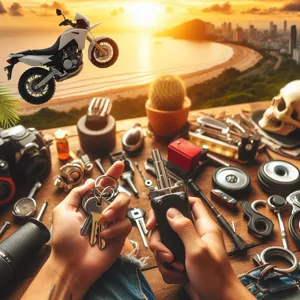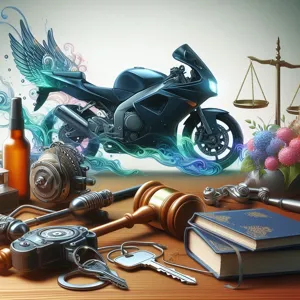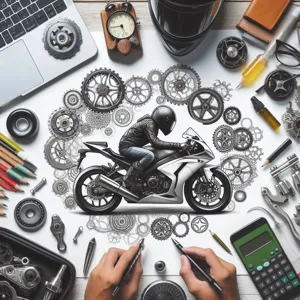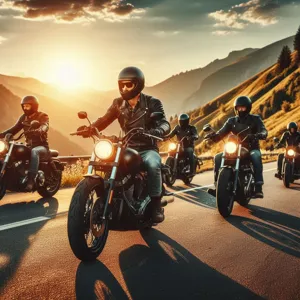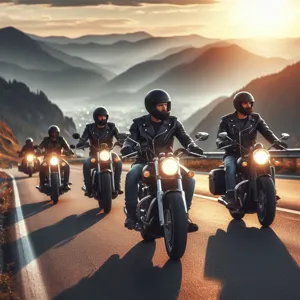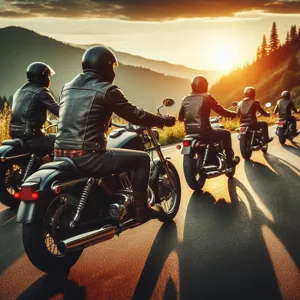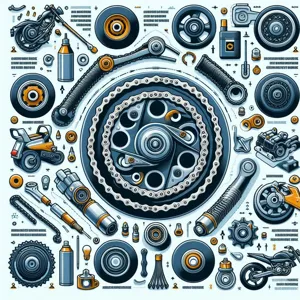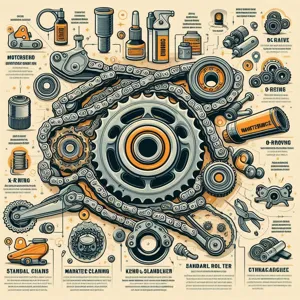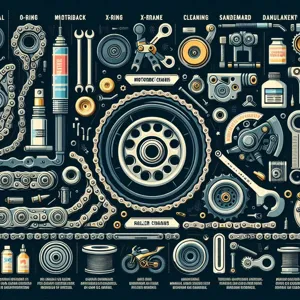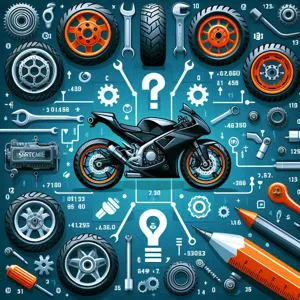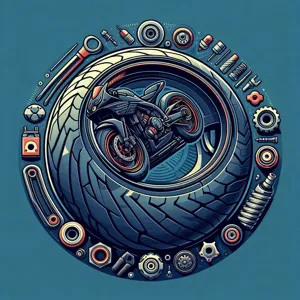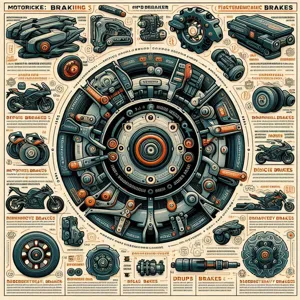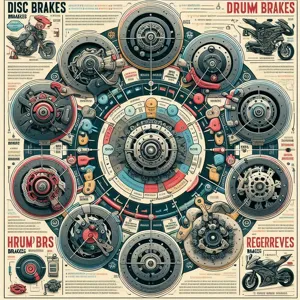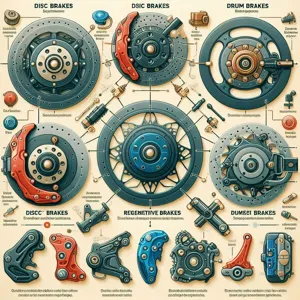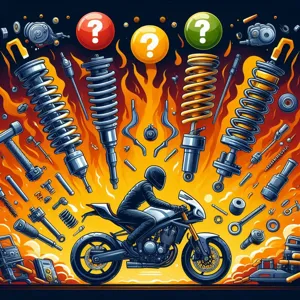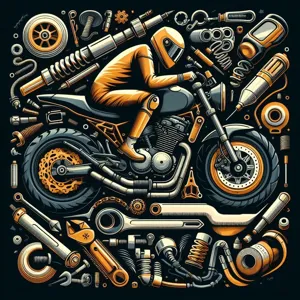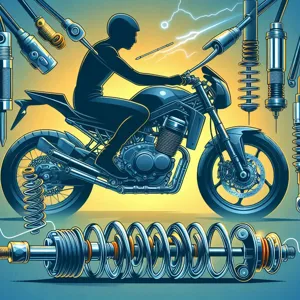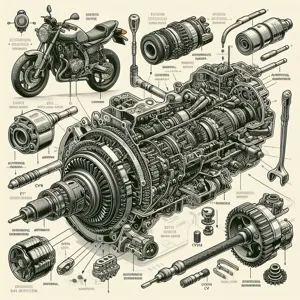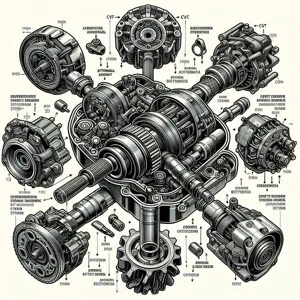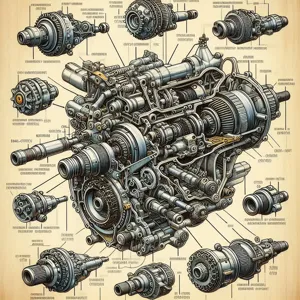In the world of motorbiking, the thrill of the open road is only enhanced by the right tools and technology at your fingertips.
Whether you’re planning an epic cross-country trip or simply commuting through the city, having the best apps can elevate your riding experience to new heights. From navigation that keeps you on the most scenic routes to communication tools that connect you with fellow riders, and adventure apps that help you uncover hidden gems along the way, the digital landscape offers a wealth of resources for every motorbike enthusiast. In this blog post, we’ll explore the top 10 must-have motorbike apps that not only streamline your rides but also enhance safety and foster a sense of community. Get ready to rev up your adventures and discover how these innovative tools can transform your journeys into unforgettable experiences!
1. Introduction: The Importance of Apps for Motorbike Riders

In today’s fast-paced world, where technology seamlessly integrates with our daily lives, motorbike riders can harness the power of mobile applications to enhance their riding experience dramatically. Whether you’re a seasoned biker hitting the open road or a casual weekend rider, the right apps can transform your journey, offering tools for navigation, communication, and adventure. As the landscape of motorcycling evolves, so too does the need for riders to stay connected and informed.
Apps tailored specifically for motorbike enthusiasts serve as essential companions, ensuring that you never lose your way, can easily communicate with fellow riders, and can even discover new routes and adventures. Imagine cruising down a scenic highway with a reliable navigation app guiding your path, while a communication tool allows you to stay in touch with your riding buddies, all while discovering hidden gems along the way. These applications not only enhance safety but also enrich the overall experience of being on two wheels.
With countless apps available, it can be overwhelming to sift through the options. That’s why we’ve compiled a list of the top 10 must-have motorbike apps that cater to every rider’s needs. From route planners to real-time traffic updates and even community-driven platforms, our selection has something for everyone. So, whether you’re planning a long-distance trip or just want to explore your local area, these apps will ensure that you ride with confidence and excitement. Let’s dive into the must-have apps that can take your motorcycling adventures to the next level!
2. Criteria for Choosing the Best Motorbike Apps
When it comes to selecting the best motorbike apps, a few key criteria can make all the difference in ensuring a smooth ride and an enhanced experience on the road. Here are the essential factors to consider:
1. **User-Friendly Interface:** The best apps should have an intuitive design that allows for easy navigation, even when you’re on the go. Look for apps that prioritize simplicity, with clean layouts and accessible menus, so you can focus on the road ahead rather than fumbling with your device.
2. **Offline Functionality:** Riding often takes us to remote areas where cellular service is spotty at best. Opt for apps that offer offline maps and features, ensuring that you can still navigate or access vital information without a data connection.
3. **Real-Time Updates:** Traffic conditions, weather changes, and road closures can significantly impact your journey. Choose apps that provide real-time updates, giving you the ability to reroute as needed and avoid unexpected delays or hazardous conditions.
4. **Community Features:** Whether it’s sharing ride routes, tips, or experiences, apps with social features can enhance your motorcycling journey. Look for platforms that connect you with other riders, allowing for shared adventures and the exchange of valuable insights.
5. **Customization Options:** Every rider has unique preferences, from preferred routes to waypoints. The best motorbike apps allow for customization, so you can tailor your navigation experience to suit your individual riding style and interests.
6. **Safety Features:** Your safety should always be a priority. Choose apps that incorporate safety features such as speed alerts, crash detection, or emergency contact options. These tools can provide peace of mind as you navigate the open road.
7. **Integration with Other Devices:** Many riders use additional tech, such as smart helmets or Bluetooth communication systems. Look for apps that can seamlessly integrate with your existing gear, enhancing functionality without the hassle of managing multiple devices.
8. **Comprehensive Trip Planning Tools:** The best apps should not only help you navigate but also assist in planning your entire trip. Features like route optimization, fuel stops, and points of interest can help you create an enjoyable and well-organized journey.
By considering these criteria, you can find the perfect motorbike apps that will not only enhance your navigation and communication but also elevate your overall riding experience. Whether you’re embarking on a cross-country adventure or simply exploring local trails, having the right tools at your fingertips will make all the difference.
3. Top Navigation Apps for Motorcyclists

When it comes to hitting the open road on two wheels, having the right navigation app can make all the difference. For motorcyclists, navigation isn’t just about getting from point A to point B; it’s about the journey, the scenic routes, and the thrill of exploration. Here are some of the top navigation apps specifically designed for motorcyclists that can enhance your riding experience.
**1. Rever:** Rever is a dedicated app for motorcyclists that not only provides robust navigation features but also enables riders to track their routes, share rides with friends, and explore new roads. With a user-friendly interface, Rever allows you to create custom routes based on your preferences, whether you’re looking for twisty backroads or breathtaking scenic views. You can even discover popular rides shared by other users, turning every ride into an adventure.
**2. Calimoto:** Tailored for motorcycle enthusiasts, Calimoto is an app that emphasizes adventure riding. This app specializes in finding the best motorcycle routes, focusing on curvy roads and breathtaking landscapes. With its route planner, you can customize your journey and receive real-time updates, ensuring you never miss a turn or a stunning view along the way. Plus, the app lets you log your rides and keep track of your favorite routes.
**3. Waze:** While not exclusively for motorcyclists, Waze offers unique features that can be incredibly beneficial for two-wheeled travelers. This community-driven navigation app provides real-time traffic updates, road alerts, and the ability to find the quickest routes to avoid congested areas. Its user-friendly interface and voice navigation ensure you stay focused on the road ahead, making your ride smoother and more enjoyable.
**4. Google Maps:** A staple for any traveler, Google Maps has features that cater well to motorcyclists. With options to avoid tolls and highways, you can easily find scenic routes that enhance your riding experience. Additionally, the offline maps feature is invaluable for those times when you’re venturing into areas with limited cellular service. Just download your route before you head out, and you’ll always know where you’re going.
**5. HERE WeGo:** This app is another fantastic option for those who prefer offline navigation. HERE WeGo offers reliable turn-by-turn guidance and route options tailored for different types of vehicles, including motorcycles. With its detailed maps and the ability to download areas for offline use, you can confidently explore new terrains without worrying about losing your way.
With these top navigation apps, you can elevate your motorcycling adventures, ensuring you find the most thrilling routes, stay safe on the roads, and always know where you’re headed. Whether you’re a weekend warrior or a long-distance traveler, having the right navigation tools at your fingertips can transform your ride into an unforgettable experience.
– 3.1. Google Maps
When it comes to navigation, Google Maps is an indispensable tool for any motorbike enthusiast. This app offers a user-friendly interface that seamlessly integrates with your smartphone, providing real-time GPS tracking and turn-by-turn directions. Whether you’re cruising through the bustling streets of a city or exploring winding country roads, Google Maps helps you find the fastest and most efficient routes, ensuring that you spend less time lost and more time enjoying the ride.
One of the standout features of Google Maps is its ability to offer multiple transportation modes, including a specific option for biking. This feature provides tailored routes that take into account bike paths, trails, and less-traveled roads, allowing you to enjoy a safer and more scenic experience. Plus, with offline map capabilities, you can download your routes ahead of time, ensuring you won’t lose your way even in areas with poor cellular service.
Google Maps also excels in providing valuable information about the area surrounding your journey. Need to refuel? The app can show you the nearest gas stations along your route. Feeling hungry? A quick glance will reveal nearby restaurants and cafes, complete with reviews and ratings to help you decide where to stop. Additionally, it features user-generated content, allowing you to explore points of interest, landmarks, and hidden gems that might enhance your adventure.
With regular updates and a vast database of locations, Google Maps is not just a navigation tool but a complete companion for your motorbike excursions. Whether you’re planning a weekend getaway or a spontaneous ride, this essential app ensures that you stay on track and make the most out of every ride. So, gear up and let Google Maps guide your next adventure on two wheels!
– 3.2. Waze

When it comes to navigating the open road, Waze stands out as a favorite among motorcyclists for its real-time, community-driven features. This app is not just a traditional GPS; it’s a vibrant social network of drivers and riders working together to create a smoother, safer journey for everyone on the road.
Waze harnesses user-generated data to provide up-to-the-minute traffic updates, alerting you to accidents, road closures, and even speed traps along your route. As a motorcyclist, this information can be invaluable, allowing you to adjust your path on the fly, avoid congested areas, and find the quickest routes to your destination. The app’s intuitive interface makes it easy to set up your ride and start navigating with just a few taps.
One of Waze’s standout features is its ability to highlight motorcycle-friendly routes, which can be a game-changer for those looking to enjoy the thrill of winding country roads or scenic byways. Additionally, the app offers voice-guided navigation, ensuring you can keep your eyes on the road while still receiving clear directions.
Waze also encourages safety by enabling users to report hazards and incidents, making it a collective effort to keep fellow riders informed. Whether you’re commuting to work, embarking on a weekend adventure, or simply exploring new areas, having Waze on your phone can make your ride more enjoyable and efficient. With its robust community support and innovative tools, Waze is an essential app for any motorcyclist looking to enhance their navigation experience.
– 3.3. Calimoto
Calimoto is a must-have app for any motorbike enthusiast looking to enhance their riding experience. Designed specifically for bikers, Calimoto goes beyond standard navigation by combining the thrill of adventure with the practicality of route planning. As you fire up the app, you’ll be greeted with a sleek interface that allows you to effortlessly discover scenic routes tailored to your riding style.
One of Calimoto’s standout features is its ability to generate personalized itineraries based on your preferences. Whether you’re in the mood for a leisurely cruise through winding country roads or a thrilling ride along mountain passes, Calimoto curates the best routes that keep you off the beaten path and in the heart of nature’s beauty. The app takes into account not just distance, but also the quality of the roads, ensuring that every mile you ride is enjoyable.
In addition to route planning, Calimoto offers an intuitive navigation system that provides turn-by-turn directions, making it easy to focus on the road ahead. The app also includes offline maps, which are a lifesaver when you’re venturing into areas with spotty cell service. Plus, the integrated weather forecasts keep you informed about conditions along your route, helping you avoid unexpected rain showers or extreme temperatures.
Another exciting feature is the ability to log your rides, allowing you to track your journeys, distances, and the total number of kilometers ridden. You can also share your favorite routes with fellow riders, fostering a sense of community among bikers. With Calimoto, every ride becomes not just a means of transportation, but an adventure waiting to unfold.
Whether you’re planning a weekend getaway or simply exploring your local area, Calimoto is an indispensable companion that ensures you stay on course, discover new paths, and make the most of every ride. Download it today and unlock the full potential of your motorbike adventures!
4. Best Communication Apps for Riders

In the world of motorbiking, communication is key—not just for safety, but also for enhancing the overall riding experience. Whether you’re riding solo or with a group, the right communication app can make a significant difference in how you connect with fellow riders and navigate your adventures. Here’s a look at some of the best communication apps designed specifically for motorcyclists.
**1. Sena Utility App:** If you’re using a Sena Bluetooth headset, the Sena Utility App is a must-have. This app allows you to manage your device settings, update firmware, and even create group intercom connections with other Sena users. With features like music sharing and intercom functionality, it keeps you connected to your riding buddies while on the road.
**2. Bike-to-Bike:** For those who prefer a more direct line of communication, the Bike-to-Bike app offers a simple yet effective way to communicate with other riders in your group. It utilizes your phone’s GPS and Bluetooth technology to create a mesh network, allowing you to send voice messages and location updates without needing a cellular signal.
**3. Blemor:** This app is perfect for those who ride in large groups. Blemor allows you to communicate with multiple riders simultaneously through a private channel. The app also supports text and voice messaging, making it easy to share important updates or route changes without needing to stop.
**4. WhatsApp:** While not motorcycle-specific, WhatsApp is a versatile communication tool that many riders swear by. With its group chat function, you can easily coordinate with your riding group, share locations, and send photos of your latest adventures. Plus, the app’s end-to-end encryption ensures that your conversations remain private.
**5. Zello:** Zello turns your phone into a walkie-talkie, making it an excellent choice for riders who need instant communication. It allows you to create channels where you can chat with friends in real time, which is perfect for group rides or navigating through busy traffic. Zello also works over Wi-Fi, so you can stay connected even when cell service is spotty.
**6. GroupMe:** Another great option for group coordination, GroupMe is perfect for organizing events or rides with friends. You can create a group chat, share photos, and even send direct messages. Its user-friendly interface makes it easy to stay in touch, ensuring that no one gets lost along the way.
Incorporating these communication apps into your riding routine can help ensure that you and your fellow riders stay connected, informed, and safe no matter where your adventures take you. Whether you’re navigating winding mountain roads or exploring new cities, having a reliable communication tool at your fingertips can enhance your experience and foster camaraderie among riders. So gear up, download these essential apps, and hit the road with confidence!
– 4.1. Rever
When it comes to enhancing your motorbike adventures, Rever stands out as one of the top must-have apps for riders. This comprehensive platform is designed specifically for motorcycle enthusiasts, combining navigation, tracking, and social networking features into a single, user-friendly interface.
With Rever, you can explore a vast library of curated motorcycle routes, ranging from scenic byways to thrilling twisty mountain roads. The app allows you to search for rides based on your location or customize your own route, giving you the freedom to discover new paths and hidden gems that you might not find in traditional navigation apps. Whether you’re planning a weekend getaway or a cross-country trek, Rever’s mapping technology ensures that you stay on the right track while enjoying the ride.
In addition to its robust navigation capabilities, Rever also offers a unique tracking feature. You can record your rides, monitor your performance, and share your adventures with a vibrant community of fellow motorcyclists. The app allows users to log their trips, track mileage, and even earn badges for accomplishments, turning each journey into a memorable experience.
Moreover, Rever fosters a sense of community by enabling you to connect with other riders. You can follow friends, share your favorite routes, and join group rides, enhancing the social aspect of motorcycling. The app also integrates seamlessly with various Bluetooth devices, allowing for hands-free communication and navigation prompts.
Whether you’re a seasoned rider or a newcomer eager to explore the open road, Rever is an invaluable tool that keeps you connected, engaged, and eager for your next adventure. By combining navigation with community-driven elements, Rever not only enhances your riding experience but also ignites your passion for the journey ahead.
– 4.2. Zello
When it comes to communication on the road, Zello is a game-changer for motorbike enthusiasts. This app transforms your smartphone into a walkie-talkie, enabling real-time voice communication with fellow riders without the need for cellular service. Imagine cruising down winding roads or conquering rugged terrains, all while staying connected with your riding group with just the push of a button. Zello operates over Wi-Fi or data, making it an ideal choice for group rides, especially in remote areas where traditional cell service may falter.
The app is incredibly user-friendly, featuring a simple interface that allows you to create channels for your riding buddies or join existing ones to connect with other motorcyclists. This fosters a sense of community, as you can share tips, route information, and even rally cries while on the move. Additionally, Zello’s ability to record conversations means you can capture important bits of information or memorable moments during your adventures to revisit later.
With Zello, you won’t have to shout over the roar of your bike’s engine or struggle to hear your friends through the wind. Its clear audio quality ensures that every message comes through loud and clear, enhancing safety as you can quickly relay important information, like upcoming hazards or route changes. Plus, the app is available on both Android and iOS, making it accessible for all riders.
By incorporating Zello into your motorbike app arsenal, you elevate your riding experience, making it not just about the journey, but also about the connections you forge along the way. Whether you’re navigating tricky terrains or sharing the thrill of the open road, Zello keeps you in touch, ensuring that your adventures are not just experienced solo, but shared with a community of riders who are just as passionate as you are.
– 4.3. Sena Utility App
For riders who prioritize seamless communication and enhanced safety on the road, the Sena Utility App is an indispensable companion. Designed specifically to work in tandem with Sena’s Bluetooth headsets, this app transforms your riding experience by integrating advanced features that keep you connected, informed, and entertained.
One of the standout functionalities of the Sena Utility App is its ability to manage and customize your headset settings effortlessly. Whether you want to adjust the audio levels or tweak the intercom settings, the app provides an intuitive interface that allows you to make real-time changes without fumbling with buttons while riding. This means you can focus on the road ahead while still enjoying your preferred sound environment—be it music, navigation prompts, or communication with fellow riders.
Another feature that sets the Sena Utility App apart is its group intercom function. This feature facilitates easy communication among multiple riders within a group, ensuring that everyone stays connected, whether you’re navigating through city traffic or cruising down winding country roads. The app also allows you to create and manage different intercom groups, so you can customize your riding experience based on your companions.
Additionally, the Sena Utility App integrates with other navigation and music apps, allowing you to sync your routes and playlists directly with your headset. Imagine riding through picturesque landscapes while enjoying your favorite tunes or getting turn-by-turn directions without having to glance at your phone. This level of integration enhances both the adventure and the practical aspects of motorbiking.
For those who love to document their journeys, the app also offers the ability to share your ride with friends in real-time. This feature adds a layer of safety, as your loved ones can track your route and estimated arrival time, giving you peace of mind as you explore new terrains.
In summary, the Sena Utility App is more than just a tool; it’s a versatile companion that elevates your riding experience. By keeping you connected, ensuring safety, and enhancing your enjoyment on the road, this app is a must-have for any serious motorbike enthusiast looking to navigate, communicate, and embark on adventures with confidence.
5. Adventure and Planning Apps
When it comes to embracing the thrill of the open road, adventure and planning apps are indispensable tools for motorbike enthusiasts. These apps not only help you navigate new terrains but also enhance your overall riding experience by providing valuable insights and resources tailored to your journey.
**1. Komoot**: This app is a favorite among off-road riders and adventure seekers. With its user-friendly interface, Komoot allows you to plan your route based on your preferred type of terrain, whether it’s a scenic coastal ride or a challenging mountain trail. Plus, it offers detailed topographical maps and points of interest along your route, ensuring you don’t miss those breathtaking views or hidden gems.
**2. Rever**: Rever is more than just a navigation tool; it’s a community for motorbike enthusiasts. The app allows you to plan, track, and share your rides with fellow bikers, helping you discover new routes and connect with other riders who share your passion for adventure. With its built-in ride planner, you can customize your trips, log your mileage, and even compete in challenges to keep the thrill alive.
**3. Road Trip**: Perfect for long-distance riders, the Road Trip app helps you plan epic journeys by calculating fuel costs, estimating travel time, and allowing you to save your favorite routes. The app also features a robust database of points of interest, making it easier to find attractions, restaurants, and accommodations along the way.
**4. Motorcycle GPS**: Specialized for motorbike riders, this app delivers turn-by-turn navigation specifically designed for two-wheeled vehicles. It takes into account the unique dynamics of motorcycle travel, offering routes that avoid highways and prioritizing scenic backroads. With voice-guided navigation and a simplified interface, you can focus on the ride ahead.
**5. AllTrails**: For those who love to combine biking with exploration, AllTrails is the perfect app. It provides a comprehensive database of trails, including user-generated reviews and photos. Whether you’re looking to explore urban paths or hit rugged trails, AllTrails helps you find the best routes while ensuring you’re well-prepared with maps and trail information.
Incorporating these adventure and planning apps into your riding routine not only simplifies your journey but also enhances the experience, allowing you to discover new routes, connect with fellow riders, and make unforgettable memories along the way. So gear up, download these must-have apps, and get ready to hit the road with confidence and excitement!
– 5.1. Roadtrippers
For motorbike enthusiasts who crave the thrill of the open road, **Roadtrippers** is an indispensable app that transforms ordinary journeys into extraordinary adventures. Designed for those who love to explore, this app allows riders to plan their routes with an emphasis on discovering unique attractions along the way. Whether you’re embarking on a weekend getaway or a cross-country trek, Roadtrippers helps you uncover hidden gems that might otherwise go unnoticed.
With its user-friendly interface, you can easily input your starting point and destination, and the app will generate a customizable route filled with points of interest. From quirky roadside diners and stunning scenic viewpoints to historical landmarks and breathtaking national parks, Roadtrippers ensures that every ride is a memorable experience.
One of the standout features of Roadtrippers is its extensive database of attractions, which includes reviews and ratings from fellow travelers. This not only helps you decide which stops are worth your time but also allows you to connect with the biking community through shared experiences and recommendations. Plus, the app offers the ability to save your favorite routes and share them with friends, making it a perfect companion for group rides.
Additionally, Roadtrippers provides offline access to your maps and routes, so you can navigate through remote areas without worrying about losing signal. As you weave through winding roads and picturesque landscapes, this app keeps you informed and inspired, turning each journey into a treasure hunt of exploration.
In short, with Roadtrippers by your side, the world becomes your playground, and every ride can be a new chapter in your adventure tale. So gear up, hit the road, and let the app guide you to the next unforgettable destination!
– 5.2. MyRoute-app
For those who crave adventure on two wheels, **MyRoute-app** is an indispensable tool that elevates your riding experience to new heights. This app is not just a navigation tool; it’s a comprehensive route planner designed specifically for motorcyclists. With its user-friendly interface and rich features, you can create, customize, and share routes that suit your riding style and preferences.
One of the standout features of MyRoute-app is its ability to generate routes based on your personal criteria. Whether you prefer winding country roads, scenic coastal highways, or urban explorations, the app allows you to filter routes to find the perfect ride. You can even plan multi-day trips, complete with waypoints and stops, making it ideal for long-distance journeys or weekend getaways.
Additionally, MyRoute-app offers a vibrant community of fellow riders. You can browse shared routes from other users, gaining insights into popular rides and hidden gems that you might otherwise miss. The social aspect of the app encourages engagement, allowing you to connect with fellow motorbike enthusiasts and exchange tips and experiences.
Another impressive function is the offline map capability. Once you’ve planned your route, you can download maps for offline use, ensuring you’re never left without guidance, even in areas with poor cell service. This feature is crucial for those who love to venture off the beaten path, as it allows you to explore remote regions without the fear of losing your way.
Moreover, MyRoute-app seamlessly integrates with various GPS devices, so you can send your routes directly to your bike’s navigation system, ensuring a smooth transition from planning to riding. With real-time traffic updates and the ability to adjust your route on the fly, you can navigate with confidence, knowing that you’re always on the best path to adventure.
In summary, MyRoute-app is more than just a navigation tool; it’s a gateway to exploration that empowers motorcyclists to discover new routes, share experiences, and enhance their journeys. Whether you’re a casual rider or a seasoned adventurer, this app is a must-have on your smartphone, ensuring every ride is unforgettable.
– 5.3. Kurviger
For motorbike enthusiasts who revel in the thrill of the ride, Kurviger is an indispensable app that transforms ordinary journeys into exhilarating adventures. Specifically designed for motorcycle navigation, Kurviger allows riders to tailor their routes to favor twisty, scenic roads over mundane highways. The app’s user-friendly interface lets you easily plot your journey, highlighting the most enjoyable paths while avoiding traffic-heavy routes.
One of Kurviger’s standout features is its ability to calculate routes based on your riding preferences. You can choose from various options, such as the “Curvy” option for those who crave winding roads or the “Fast” option for those looking to reach their destination quickly. The app will then display a detailed map with turn-by-turn navigation, ensuring you never miss a bend or overlook a breathtaking viewpoint.
Additionally, Kurviger boasts an offline mode, which is a game-changer for riders venturing into areas with limited cell service. You can download your route in advance, allowing you to navigate without relying on a data connection. This is particularly useful for exploring remote trails or embarking on long-distance rides through the countryside.
Riders can also benefit from the app’s community features, including sharing routes with fellow bikers and discovering popular rides created by other users. With Kurviger, you’ll not only find the best roads to enjoy on your bike but also connect with a passionate community of fellow motorbike adventurers. Whether you’re planning a weekend getaway or a cross-country journey, Kurviger ensures that your rides are just as thrilling as the destination itself.
6. Safety and Maintenance Apps
When it comes to motorbiking, safety and maintenance are paramount. Thankfully, the digital realm offers a plethora of apps designed to keep you informed and your bike in top shape. These apps not only help you monitor your motorcycle’s health but also provide vital information to enhance your riding experience, ensuring that safety is always a priority.
One standout app in this category is **Motorcycle Maintenance**, which allows you to track service schedules, oil changes, tire pressures, and other essential maintenance tasks. This app sends you push notifications to remind you when it’s time for a check-up, helping you avoid those costly repairs that come from neglect. Additionally, it can store records of past services, making it easy to refer back when it’s time to sell your bike or simply keep an eye on its history.
For safety, consider downloading **Waze** or **Google Maps**, both of which offer real-time traffic updates and route suggestions that can help you avoid hazardous conditions. But don’t overlook the specialized safety apps like **Life360**; this app allows you to share your location with loved ones while you ride, giving them peace of mind that you are safe on the road. In the unfortunate event of an accident, it can also send alerts to emergency contacts, providing them with your location for quick assistance.
Moreover, the **Biker SOS** app is a must-have for those who like to ride in remote areas. This app not only tracks your ride but can also detect crashes and automatically send out an SOS message, complete with your GPS coordinates, to your predefined emergency contacts.
Lastly, exploring apps like **RevZilla** or **CycleGear** can provide you with maintenance tips and tutorials, ensuring you’re well-equipped to handle minor repairs and adjustments on the go. With the right safety and maintenance apps at your fingertips, you can ride with confidence, knowing that you’re well-prepared for any adventure that comes your way. Whether you’re cruising through city streets or exploring backcountry trails, these apps empower you to stay safe and keep your motorcycle in peak condition.
– 6.1. Motorcycle Maintenance Log
Keeping your motorcycle in peak condition is paramount for both safety and performance, and a Motorcycle Maintenance Log app can be your best ally in achieving this. Think of it as your bike’s personal diary, meticulously tracking every aspect of its care and upkeep. With this application, you can easily record routine maintenance such as oil changes, tire rotations, and brake replacements, ensuring that no essential service slips through the cracks.
Imagine riding down winding roads, the thrill of the journey heightened by the knowledge that your bike is well-maintained. The app allows you to set reminders for upcoming service dates, so you’ll never have to worry about missing an important check-up. You can even input details about your riding habits, like mileage and fuel consumption, giving you valuable insights into your bike’s performance over time.
Many of these apps offer a user-friendly interface with customizable features, allowing you to photograph receipts or parts, log expenses, and even share your maintenance history with a mechanic if needed. Some go a step further by providing troubleshooting tips and how-to guides for common repairs, empowering you to tackle minor issues on your own.
Whether you’re a seasoned motorcycle enthusiast or a new rider eager to learn, a Motorcycle Maintenance Log app is an essential tool that not only enhances your riding experience but also extends the life of your beloved machine. With everything documented at your fingertips, you can hit the road with confidence, knowing that your bike is always road-ready.
– 6.2. CrashLight
When it comes to safety on the road, CrashLight is more than just an app; it’s a guardian angel for motorcyclists. Designed with the awareness that accidents can happen in the blink of an eye, CrashLight provides a comprehensive safety solution that ensures you’re never alone, even when things go wrong.
With its intuitive interface, CrashLight employs advanced sensors in your smartphone to detect when an accident has occurred. The app works by monitoring changes in speed, direction, and impact, instantly recognizing if you’ve been involved in a crash. If a serious accident is detected, CrashLight alerts your pre-selected emergency contacts—whether it’s family, friends, or emergency services—ensuring that help is on the way, no matter where you are.
But CrashLight doesn’t stop there; it also features a built-in first-aid guide, giving you immediate access to critical information on how to respond in the event of an accident. This ensures that you can provide assistance to yourself or others until help arrives.
Furthermore, the app allows users to share their ride with friends or family, providing them with real-time location updates. This feature not only enhances safety but also allows loved ones to track your journey, adding an extra layer of peace of mind.
In a world where motorcycle adventures fuel our passion for freedom, having an app like CrashLight is essential. It seamlessly integrates safety into your riding experience, ensuring that you can enjoy the thrill of the open road while staying connected and protected. Don’t hit the road without it—because when adventure calls, it’s best to be prepared for anything!
7. Social and Community Apps
In the world of motorbiking, the journey is often just as important as the destination, and what better way to enhance both than by connecting with fellow riders? Social and community apps are essential tools for any biker looking to enrich their riding experience and forge lasting friendships on the road. These platforms allow you to share your adventures, swap tips, and even plan group rides with like-minded enthusiasts.
Apps like **Meetup** and **Bikemap** create opportunities for riders to discover local events, join riding clubs, and participate in organized rides. Whether you’re looking for a casual weekend ride or an epic cross-country adventure, these apps help you connect with others who share your passion for motorcycling.
Additionally, platforms such as **Facebook Groups** and **Instagram** can serve as vibrant hubs for discussions, advice, and inspiration. You can easily find a plethora of groups dedicated to specific bike brands, types of riding, or regional communities, allowing you to engage with others who understand the thrill of the open road. Sharing photos, stories, and experiences can foster a sense of camaraderie and support that enriches your riding journey.
Furthermore, specialized apps like **Waze** offer community-driven navigation, alerting you to road hazards and traffic updates in real time, all contributed by other users. This not only enhances your ride but also builds a sense of community among riders looking out for each other.
Incorporating social and community apps into your motorbike toolkit not only enhances your navigation experience but also transforms your rides into adventures filled with connections, knowledge, and camaraderie. So whether you’re seeking a riding partner, looking for local bike events, or just wanting to share your latest adventure, these apps are indispensable for building a supportive and engaging riding community.
– 7.1. Meetup
For motorbike enthusiasts, the thrill of the ride is often amplified by the camaraderie of fellow riders. Meetup is the perfect app to facilitate this communal spirit, allowing you to connect with like-minded individuals who share your passion for motorcycling. With its user-friendly interface, you can discover local motorcycle clubs, group rides, and events tailored to your interests.
Imagine cruising through scenic routes with a group of new friends, sharing stories and tips, and exploring hidden gems that you might never have discovered on your own. The Meetup app allows you to search for biking events in your area, filter them by date and type, and even RSVP to rides that catch your eye. Whether you’re looking for a casual weekend ride, a more structured tour, or even a motorcycle maintenance workshop, Meetup has something for everyone.
Additionally, the app fosters a sense of community, enabling you to chat with other users and get to know your fellow riders before hitting the road together. By joining a motorcycle group, you not only enhance your riding experience but also forge lifelong friendships with people who understand the thrill of the open road.
In an age where technology can sometimes feel isolating, Meetup stands out as a beacon for collaboration and shared experiences. So, before you set out on your next adventure, check out Meetup to find your riding tribe and make every journey more memorable!
– 7.2. Facebook Groups for Riders
In the digital age, community has taken on a whole new meaning, and for motorbike enthusiasts, Facebook Groups have emerged as a vibrant hub for connection, support, and shared experiences. These online communities are not just chat rooms; they are dynamic forums where riders from all walks of life come together to discuss everything from the latest gear and bike modifications to epic road trip routes and safety tips.
Joining a Facebook Group dedicated to motorcycling can significantly enhance your riding experience. Imagine having access to a wealth of knowledge at your fingertips—questions about the best routes for a weekend ride, recommendations for the most trusted mechanics in your area, or advice on handling specific bike issues can all be answered by fellow riders who have been in your shoes. The camaraderie fostered in these groups often leads to real-life meetups, ride-outs, and events, allowing you to forge friendships and connections that extend beyond the screen.
Moreover, these groups are a fantastic way to stay informed about upcoming motorcycle events, rallies, and local meetups. Members frequently share their adventures, post stunning photos of their rides, and even organize group rides, turning solo trips into shared adventures. Whether you’re a seasoned rider or just starting, the support and encouragement found in these communities can be invaluable.
In addition to practical advice and social bonding, many Facebook Groups also serve as platforms for advocacy and awareness about motorcycle safety and policy issues. Riders can discuss and promote initiatives that affect motorcyclists, creating a stronger voice for the community.
So, if you haven’t yet tapped into the potential of Facebook Groups for riders, you’re missing out on a powerful resource. Dive into the conversations, share your experiences, and let the community enhance your passion for riding—because riding is always better when you have a crew behind you, no matter where the road takes you!
8. How to Combine Apps for Optimal Riding Experience
In the ever-evolving world of motorbiking, the right combination of apps can transform an ordinary ride into an extraordinary adventure. To achieve this optimal riding experience, it’s essential to integrate navigation, communication, and adventure apps in a way that complements your journey, ensuring both safety and enjoyment.
Start by pairing your navigation app—such as Google Maps or Waze—with a dedicated motorbike-specific app like Komoot or Scenic. These specialized apps not only offer tailored routes that favor scenic backroads and off-the-beaten-path trails but often include features like elevation profiles and points of interest. By syncing these apps together, you can plan your route with both efficiency and excitement, avoiding highways in favor of winding roads that showcase the beauty of your surroundings.
Next, enhance your ride by integrating a communication app like Sena or Cardo with your navigation setup. With Bluetooth headsets, you can receive turn-by-turn directions directly in your helmet, allowing you to keep your eyes on the road while ensuring you never miss a beat. These apps also allow for seamless communication with fellow riders, making it easy to share directions or suggest spontaneous stops without the need to pull over.
For those who crave adventure, consider incorporating an app like AllTrails or Ride with GPS into your mix. These platforms enable you to discover new trails and off-road routes, cultivating a spirit of exploration. Plan a ride that combines the best navigation and communication features with the thrill of discovering hidden gems along the way.
Lastly, don’t forget to utilize a weather app to stay informed about real-time conditions. Integrating a reliable weather tracker with your other apps can help you adjust your plans on the fly, ensuring you avoid any unexpected rainstorms or temperature drops that could dampen your adventure.
By thoughtfully combining these apps, you’ll create a synergistic experience that enhances every aspect of your ride. With the right tools at your fingertips, you can navigate with confidence, stay connected with your riding group, and uncover new paths that inspire your spirit of adventure.
9. User Reviews: What Riders Are Saying
When it comes to choosing the right motorbike app, hearing from fellow riders can be invaluable. User reviews provide a rich tapestry of experiences, insights, and tips that can help you make informed decisions. In this section, we delve into what riders are saying about some of the top motorbike apps available today.
Many users praise apps like **Waze** for its real-time traffic updates and community-driven alerts, such as road hazards or police presence. One rider shared, “Waze has become my go-to app. It not only helps me dodge traffic but also shows me the best routes for a thrilling ride on twisty backroads.” The ability to customize alerts and receive updates from other riders adds a layer of camaraderie and safety to the experience.
On the other hand, apps like **REVER** have garnered attention for their features designed specifically for motorcyclists. Users rave about the app’s ability to track rides, plan routes, and connect with a community of like-minded enthusiasts. One reviewer mentioned, “I love how I can map out my rides and track my progress. It’s like having a personal ride diary!”
Communication-focused apps, such as **Intercom** and **Sena**, have also received glowing feedback. Riders appreciate the seamless connectivity these apps offer during group rides, allowing for hands-free communication without the need to stop. A user happily noted, “No more shouting across the wind—now I can chat with my buddies effortlessly while we navigate through the mountains.”
However, not all reviews are glowing. Some riders have pointed out occasional connectivity issues with certain navigation apps, particularly in remote areas. One user lamented, “I love the features, but I sometimes find the GPS signal drops when I need it most.”
Overall, user reviews provide a wealth of knowledge that can guide you in selecting the best apps for your riding style and needs. Whether you’re seeking reliable navigation, robust communication, or simply a way to connect with fellow riders, the insights of the community can help you enhance your riding experience and ensure every adventure is one to remember.
10. Conclusion: The Future of Motorbike Apps
As we look toward the horizon of the motorcycling world, it’s clear that the future of motorbike apps holds immense potential for enhancing our riding experiences. Technology continues to evolve at a breakneck pace, and with it, the capabilities of mobile applications designed specifically for bikers are expanding. Imagine a world where augmented reality overlays help you navigate tricky terrains, or where apps seamlessly integrate with your bike’s onboard systems to provide real-time diagnostics and performance analytics.
The integration of artificial intelligence is also on the rise, allowing for personalized recommendations based on your riding habits, preferred routes, and even weather conditions. Future apps may harness data from your rides to suggest new adventures, connect you with fellow riders, or alert you to potential hazards on your route.
Moreover, the emphasis on community is likely to grow, with apps fostering connections among bikers, facilitating meet-ups, and sharing experiences in a way that enriches the riding culture. Social features could evolve to allow users to track and share their journeys, creating a rich tapestry of motorcycling adventures that inspire and motivate others to hit the road.
As we embrace these innovations, it’s essential to choose apps that not only enhance navigation and communication but also contribute to a safer and more enjoyable riding experience. The motorbiking community stands at the cusp of a technological revolution, and with the right tools at our fingertips, the open road will become an even more thrilling adventure. So gear up, stay connected, and prepare to explore the limitless possibilities that await in the future of motorbike apps!
As we wrap up our exploration of the top 10 must-have motorbike apps for navigation, communication, and adventure, we hope you feel inspired to enhance your riding experience like never before. From finding the best routes to connecting with fellow riders, these apps serve as invaluable companions on every journey, ensuring you stay safe, informed, and engaged on the road. Whether you’re navigating winding backroads or planning your next big adventure, integrating these tools into your rides can make all the difference. So gear up, download your favorites, and hit the open road with confidence—your next adventure awaits! We can’t wait to hear about your experiences and any other apps you’ve discovered along the way, so feel free to share your thoughts in the comments below!









